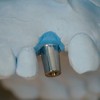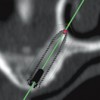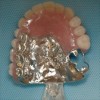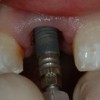The purpose of the laboratory remount is to correct errors in occlusion that have occurred during processing, to return the dentures to the correct vertical dimension of occlusion and to restore centric contacts and bilateral balanced occlusion. This program illustrates in some detail the methods used to accomplish this task.
Complete Dentures – Laboratory Remount — Course Transcript
- 1. Laboratory Remount John Beumer III, DDS, MS Division of Advanced Prosthodontics, Biomaterials and Hospital Dentistry UCLA School of Dentistry This program of instruction is protected by copyright ©. No portion of this program of instruction may be reproduced, recorded or transferred by any means electronic, digital, photographic, mechanical etc., or by any information storage or retrieval system, without prior permission.
- 2. 18. Laboratory Remount Purpose: To correct errors in occlusion that have occurred during processing To return dentures to the correct vertical dimension of occlusion To restore centric and bilateral balanced occlusion
- 3. 18. Laboratory Remount Purpose: To correct errors in occlusion that have occurred during processing To return dentures to the correct vertical dimension of occlusion To restore centric and bilateral balanced occlusion
- 4. Laboratory Remount Processed dentures intact on master casts Articulator and plaster mountings Straight handpiece and acrylic burrs Quick setting plaster Plaster bowl and spatula Articulating paper Wax spatula Instruments and Materials
- 5. The processed dentures are removed from the flasks. Lab remount – Lingualized Occlusion
- 6. Lab Remount – Lingualized Occlusion Carefully inspect the plaster mountings and the underside of the casts. Remove any stone particles or debris before joining the two together
- 7. Place each cast on its plaster mounting and check that it goes to place exactly. If the casts do not seat on the mountings properly look for particles of plaster which may be adhering to the mounting or the cast. Lab Remount – Lingualized Occlusion
- 8. Lab Remount – Lingualized Occlusion While performing the lab remount and equilibration procedure, the master cast with the polymerized denture must be effectively secured to the articulator mountings. Begin by placing notches in both the mounting and the master cast with an acrylic burr.
- 9. Lab Remount – Lingualized Occlusion Soak the cast and mountings in water for 5 minutes and add a plaster paddy on each side as shown.
- 10. Lab Remount – Lingualized Occlusion Begin by locking the centric latches and make sure the pin is set at zero. Check the amount of pin opening that has occurred secondary to processing. In this case there was less than .1 mm of opening. Zero setting
- 11. Lab Remount – Lingualized Occlusion Inspection reveals only minimal tooth movement. The pin opening following processing was less than .1 mm.
- 12. Lab Remount – Lingualized Occlusion Begin equilibrating in centric with the centric latches locked. Tap the two members of the articulator together with articulating paper interposed between. The objective is to restore the vertical dimension of occlusion to the level achieved with the trial denture and develop as many occlusal contacts as possible in centric.
- 13. Lab Remount – Lingualized Occlusion Upon initial closure missing centric contacts were noted in association with the first molars on the left and the second molars on the right. Note the occlusal contact on the buccal incline of the mesial buccal cusp of the left maxillary 2 nd molar. This contact should be eliminated.
- 14. Lab Remount – Lingualized Occlusion These contacts were restored with selective grinding. All of the grinding in this case was directed towards the central fossae of the mandibular posterior teeth.
- 15. Lab Remount – Lingualized Occlusion Following adjustment to restore centric and the VDO, some contacts on the buccal inclines of the upper posterior teeth may be noted (arrows). These should be removed. Only the lingual cusp tips of the maxillary posterior teeth should be in contact in centric.
- 16. Lab Remount – Lingualized Occlusion When you have finished equilibrating in centric there should be no contact associated with the buccal cusps of either the mandibular or the maxillary teeth, and the incisal guide pin should contact the incisal guide table.
- 17. Lab Remount – Lingualized Occlusion With the incisal guide pin at zero and in contact with the incisal guide table, the vertical dimension of occlusion has been restored.
- 18. Lab Remount – Lingualized Occlusion When the VDO has been restored, the denture is examined in working, balancing and protrusive.
- 19. Lab Remount – Lingualized Occlusion Equilibrate in working, balancing and protrusive . Working In working excursion, the maxillary lingual cusps contact the buccal inclines of the mandibular lingual cusps but the maxillary buccal cusps are not in contact.
- 20. Lab Remount – Lingualized Occlusion Equilibrate in working, balancing and protrusive . Working Note the working contacts (ovals). Bucccal side Lingual side
- 21. Lab Remount – Lingualized Occlusion Equilibrate in working, balancing and protrusive . Working Note the balancing contacts (ovals). Bucccal side Lingual side
- 22. Lab Remount – Lingualized Occlusion Balancing In balancing, the maxillary lingual cusps contact the lingual inclines of the mandibular cusps. When the exercise is completed there should be simultaneous contacts on both the working and balancing side during function.
- 23. Lab Remount – Lingualized Occlusion Protrusive Develop protrusive contacts as shown. Light contact of the anterior teeth in protrusion enhances stability. Note the contacts in the 2 nd molar region.
- 24. The processed dentures are removed from the flasks and secured to the mountings as shown previously. We are now ready to begin the laboratory remount procedure. The purpose of the laboratory remount is to adjust the occlusion to account for distortions that occur during processing. Laboratory Remount – Monoplane Occlusion Neutrocentric concept
- 25. Laboratory Remount – Monoplane Occlusion Neutrocentric concept All of the teeth, with the exception of the laterals and the cuspids (because of esthetic considerations) should be on the same plane and there should be no vertical overlap of the anterior teeth.
- 26. Laboratory Remount – Monoplane Occlusion Neutrocentric concept Close examination reveals that there has been some movement of the denture teeth during processing . Not all the teeth are on the plane of occlusion .
- 27. Laboratory Remount – Monoplane Occlusion Neutrocentric concept With a piece of fine sand paper and a flat glass slab, sand the denture teeth so that both the buccal and lingual surfaces of the posterior teeth and the incisal edges of the central incisors touch the occlusal plane. In this setup note that the cuspids and the laterals are slightly above the plane for esthetic purposes.
- 28. Laboratory Remount – Monoplane Occlusion Neutrocentric concept After this step all of the cusp tips of the posterior teeth, plus the incisal surfaces of the central incisors are on the same plane.
- 29. Laboratory Remount – Monoplane Occlusion Neutrocentric concept Attach the maxillary cast and mounting to the articulator. Make sure the incisal guide pin is set at zero. Lock the condyles. Close the articulator and note how much vertical opening has occurred as a result of processing. Insert strips of articulating paper between the teeth and lightly tap them together in centric occlusion. Premature contacts will usually show up as dark areas with a light center.
- 30. Laboratory Remount – Monoplane Occlusion Neutrocentric concept When restoring the vertical dimension of occlusion of dentures made with nonanatomic teeth make your adjustments on the mandibular arch only. The heaviest premature contacts show up as dark areas with light centers (arrow). Grind on these areas first.
- 31. Restore the Vertical Dimension of Occlusion Continue with this procedure until the incisal guide pin comes in contact with the incisal guide table. You have now restored the vertical dimension of occlusion. Flatten the occlusal plane of the mandibular arch without disturbing centric contacts so that the flat occlusal surfaces of the mandibular arch contact the flat surfaces of the maxillary arch. Neutrocentric concept
- 32. Laboratory Remount – Monoplane Occlusion Neutrocentric concept When the exercise is completed, all of the teeth, with the exception of the maxillary laterals and perhaps the cuspids (because of esthetic considerations) will be on the same plane and there will be no vertical overlap of the anterior teeth.
- 33. Lab Remount – Monoplane Occlusion Bilateral balance with balancing ramps With a piece of fine sand paper and a flat glass slab, sand the occlusal surfaces of only the posterior teeth so that both the buccal and lingual surfaces of the posterior teeth touch the occlusal plane. Note that the anterior teeth are not touched. To do so would eliminate the vertical overlap and this must be maintained in order to develop bilateral balance with the balancing ramps.
- 34. Lab Remount – Monoplane Occlusion Bilateral balance with balancing ramps When you are finished with this step, all the posterior teeth should be on the same plane.
- 35. Laboratory Remount – Monoplane Occlusion Bilateral balance with balancing ramps Attach the casts and mountings to the articulator. Make sure the incisal guide pin is set at zero. Lock the condyles. Close the articulator and note how much vertical opening has occurred as a result of processing. In this case there is almost no pin opening. Insert strips of articulating paper between the teeth and lightly tap them together in centric occlusion. Premature contacts will usually show up as dark areas with a light center.
- 36. Lab Remount – Monoplane Occlusion Bilateral balance with balancing ramps Equilibrate in centric first, as shown previously.
- 37. Lab Remount – Monoplane Occlusion Bilateral balance with balancing ramps Equilibrate in excursions Next, tract the articulator through working, balancing and protrusive. This is the working position. In the posterior region premature contacts will may be seen on the lingual cusps of the mandibular teeth. These contacts must be removed. Begin by inserting the appropriate protrusive insert. Loosen the condylar locks .
- 38. Lab Remount – Monoplane Occlusion Bilateral balance with balancing ramps Upon completion the articulator should slide easily from working to balancing to protrusive and back. There should be no bumps along the road. If the contacts on the balancing ramps are insufficient they may be supplemented with autopolymerizing acrylic resin. Balancing A successful result creates a tripod during excursions and should result in maximum stabilization of the denture bases. Protrusive Working
- 39. Lab Remount –Anatomic Occlusion Bilateral balance with balancing ramps When the exercise is completed contacts will be seen on the anterior teeth and the balancing ramps in lateral excursion.
- 40. Errors in Centric Occlusion and Their Correction a) Pairs of opposing teeth too long , holding remaining teeth out of occlusion. Solution: Fossae of the teeth in question are deepened . The cusp tips should not be shortened . b) The cusp tips of opposing teeth appear to be nearly tip to tip. Solution: Grind on the inclines so as to move the upper cusp inclines buccally and the lower cusp inclines lingually. In so doing the central fossae are made broader, the lingual cusp of the upper teeth narrowed, and the buccal cusp of the lower teeth are also narrowed. The cusp tips should not be shortened . c) Upper teeth too buccal in relation to the lower. Solution: Broaden the central fossae, and the buccal cusps of the lower teeth are moved buccally by broadening the central fossae. The cusp tips should not be shortened. Lab Remount –Anatomic Occlusion
- 41. Lab Remount – Anatomic Occlusion Restore the vertical dimension of occlusion . With an acrylic burr and a slow speed handpiece remove the occlusal prematurities until the pin is closed against the incisal guide table(arrow). In this case their was almost no pin opening.
- 42. Equilibrating in centric Initially most prematurities are found in the posterior region. Confine your initial reductions to cusp inclines, central fossae and marginal ridges . Avoid the upper lingual and lower buccal cusp tips unless absolutely required in order to reduce the incisal pin opening to zero. Lab Remount –Anatomic Occlusion
- 43. Equilibrating in centric Centric contacts are now appearing on most posterior teeth. If the incisal guide pin is still open, you may need to grind on the cusp tips in order to restore the vertical dimension of occlusion to the level determined ideal for the patient during the trial denture appointment. Lab Remount –Anatomic Occlusion
- 44. Equilibration in Centric Equilibration in centric is completed. The inicisal pin is at zero and in contact with the incisal guide table. The vertical dimension has been restored. We are now ready to begin equilibrating in working, balancing and protrusive. The first step is verify that the appropriate protrusive inserts have been placed.
- 45. Select and position the appropriate protrusive insert. Excursions Lab Remount –Anatomic Occlusion
- 46. Most occlusal discrepancies found during “working ” and “balancing” can be corrected by reducing premature contacts on the buccal cusps of the maxillary teeth and the lingual cusps of the mandibular posterior teeth (non-centric holding cusps) otherwise known as the rule of BULL (buccals of the uppers and linguals of the lowers). Lab Remount –Anatomic Occlusion Equilibration in working a) Begin by the equilibrating the right working side . Slide the articulator through right working with articulating paper between the denture teeth. Begin grinding by removing any contacts that are present on the inclines of the lower right lingual cusps as shown in the diagram (arrows).
- 47. Lab Remount –Anatomic Occlusion b) Check the contacts on the buccal inclines of the upper buccal cusps. During working, they should all be about equal. If not, make the appropriate adjustments In this case working contacts on the 2 nd molar are too light (red arrow). Working position Equilibration in working
- 48. Remount –Anatomic Occlusion c) Slide the articulator through working again and observe the contacts on the balancing side, the lingual inclines of the lower buccal cusps . Premature balancing side contacts are reduced by grinding on the lingual inclines of the lower buccal cusps. If there are no balancing side contacts, the working side contacts should be reduced until balancing side contacts appear . Continue until working and balancing contacts are about equal. d) Repeat the same sequence on the opposite side Equilibration in balancing
- 49. Equilibration in Protrusive Equilibrate in protrusive. This may require grinding of the anterior teeth as shown and selective reduction of the buccal inclines of the posterior teeth. Protrusive position
- 50. Lab Remount – Anatomic Occlusion Upon completion the articulator should slide easily from working to balancing to protrusive and back. There should be no bumps along the road. Balancing Protrusive Working


 Cement Retention vs Screw Retention
Cement Retention vs Screw Retention
 Prosthodontic Procedures and Complications
Prosthodontic Procedures and Complications
 Implants and RPDs
Implants and RPDs
 Single Tooth Defects in Posterior Quadrants
Single Tooth Defects in Posterior Quadrants
